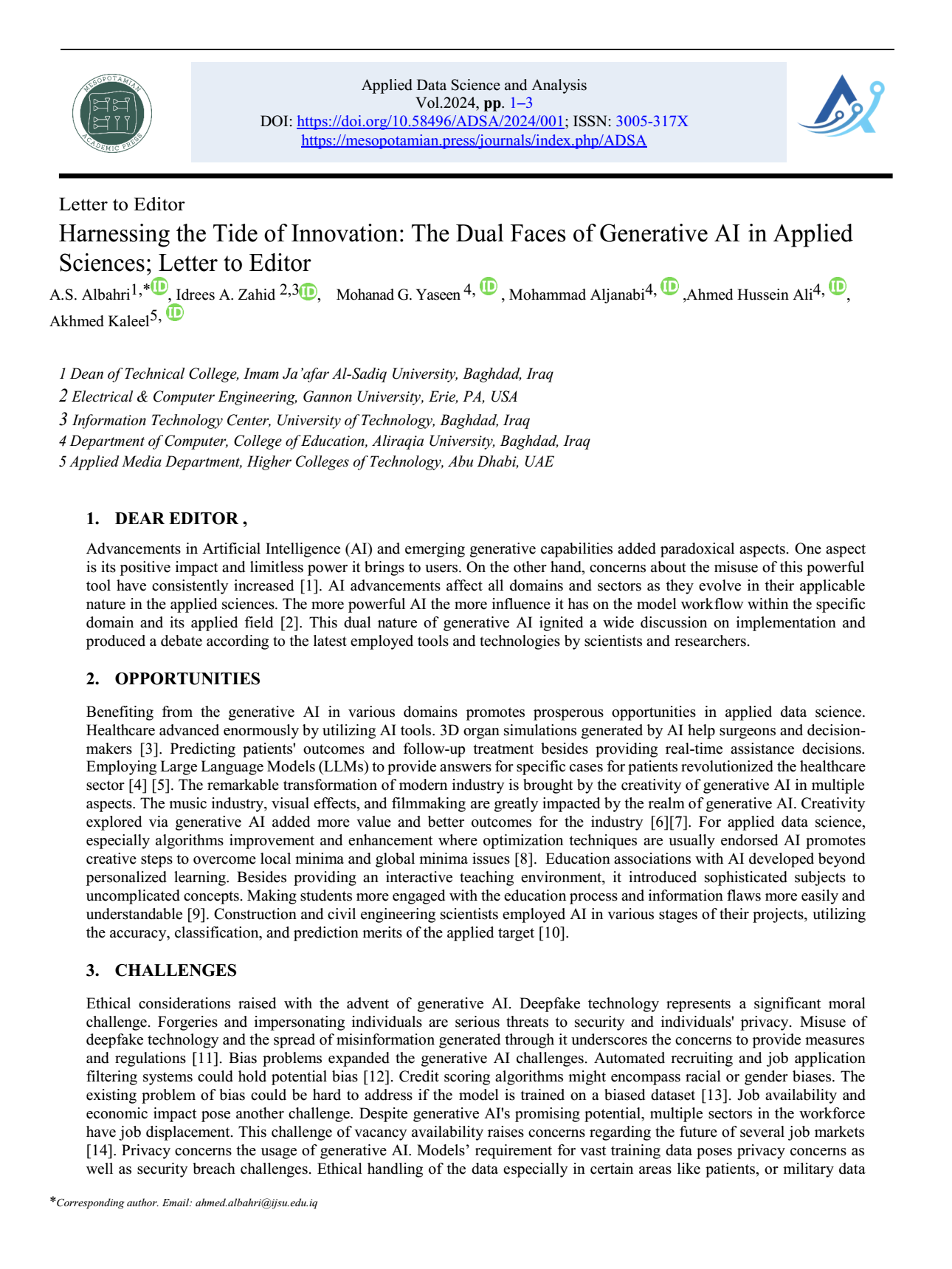Harnessing the Tide of Innovation: The Dual Faces of Generative AI in Applied Sciences; Letter to Editor
Main Article Content
Abstract
Advancements in Artificial Intelligence (AI) and emerging generative capabilities added paradoxical aspects. One aspect is its positive impact and limitless power it brings to users. On the other hand, concerns about the misuse of this powerful tool have consistently increased [1]. AI advancements affect all domains and sectors as they evolve in their applicable nature in the applied sciences. The more powerful AI the more influence it has on the model workflow within the specific domain and its applied field [2]. This dual nature of generative AI ignited a wide discussion on implementation and produced a debate according to the latest employed tools and technologies by scientists and researchers.
Article Details
Issue
Section

This work is licensed under a Creative Commons Attribution 4.0 International License.
Deprecated: json_decode(): Passing null to parameter #1 ($json) of type string is deprecated in /home/u273879158/domains/mesopotamian.press/public_html/journals/plugins/generic/citations/CitationsPlugin.php on line 68
How to Cite
References
K. B. Ooi et al., “The Potential of Generative Artificial Intelligence Across Disciplines: Perspectives and Future Directions,” J. Comput. Inf. Syst., Oct. 2023, doi: 10.1080/08874417.2023.2261010.
I. A. Zahid and S. S. Joudar, “Does Lack of Knowledge and Hardship of Information Access Signify Powerful AI? A Large Language Model Perspective,” Appl. Data Sci. Anal., vol. 2023, pp. 150–154, Dec. 2023, doi: 10.58496/ADSA/2023/014.
L. Ma, S. Yu, X. Xu, S. Moses Amadi, J. Zhang, and Z. Wang, “Application of artificial intelligence in 3D printing physical organ models,” Mater. Today Bio, vol. 23, p. 100792, Dec. 2023, doi: 10.1016/J.MTBIO.2023.100792.
B. Meskó and E. J. Topol, “The imperative for regulatory oversight of large language models (or generative AI) in healthcare,” npj Digit. Med. 2023 61, vol. 6, no. 1, pp. 1–6, Jul. 2023, doi: 10.1038/s41746-023-00873-0.
J. Varghese and J. Chapiro, “ChatGPT: The transformative influence of generative AI on science and healthcare,” J. Hepatol., Aug. 2023, doi: 10.1016/J.JHEP.2023.07.028.
M. Suh, E. Youngblom, M. Terry, and C. J. Cai, “AI as Social Glue: Uncovering the Roles of Deep Generative AI during Social Music Composition,” Conf. Hum. Factors Comput. Syst. - Proc., p. 11, May 2021, doi: 10.1145/3411764.3445219.
S. Kumar, D. Musharaf, S. Musharaf, and A. K. Sagar, “A Comprehensive Review of the Latest Advancements in Large Generative AI Models,” Commun. Comput. Inf. Sci., vol. 1920, pp. 90–103, 2023, doi: 10.1007/978-3-031-45121-8_9/COVER.
S. A. Hussein and I. A. Zahid, “Improved Naked Mole-Rat Algorithm Based on Variable Neighborhood Search for the N-Queens Problem,” Iraqi J. Sci., vol. 65, no. 1, pp. 528–545, Jan. 2024, doi: 10.24996/IJS.2024.65.1.41.
J. Qadir, “Engineering Education in the Era of ChatGPT: Promise and Pitfalls of Generative AI for Education,” IEEE Glob. Eng. Educ. Conf. EDUCON, vol. 2023-May, 2023, doi: 10.1109/EDUCON54358.2023.10125121.
H. H. M. Al-Ghabawi, M. M. Khattab, I. A. Zahid, and B. Al-Oubaidi, “The prediction of the ultimate base shear of BRB frames under push-over using ensemble methods and artificial neural networks,” Asian J. Civ. Eng., vol. 25, no. 2, pp. 1467–1485, 2024, doi: 10.1007/s42107-023-00855-3.
F. Juefei-Xu, R. Wang, Y. Huang, Q. Guo, L. Ma, and Y. Liu, “Countering Malicious DeepFakes: Survey, Battleground, and Horizon,” Int. J. Comput. Vis. 2022 1307, vol. 130, no. 7, pp. 1678–1734, May 2022, doi: 10.1007/S11263-022-01606-8.
P. Budhwar et al., “Human resource management in the age of generative artificial intelligence: Perspectives and research directions on ChatGPT,” Hum. Resour. Manag. J., vol. 33, no. 3, pp. 606–659, Jul. 2023, doi: 10.1111/1748-8583.12524.
A. Amini, A. P. Soleimany, W. Schwarting, S. N. Bhatia, and D. Rus, “Uncovering and mitigating algorithmic bias through learned latent structure,” AIES 2019 - Proc. 2019 AAAI/ACM Conf. AI, Ethics, Soc., vol. 19, pp. 289–295, Jan. 2019, doi: 10.1145/3306618.3314243.
Y. Yan et al., “Research on the impact of trends related to ChatGPT,” Procedia Comput. Sci., vol. 221, pp. 1284–1291, Jan. 2023, doi: 10.1016/J.PROCS.2023.08.117.
X. Xu, X. Liu, X. Yin, S. Wang, Q. Qi, and L. Qi, “Privacy-aware offloading for training tasks of generative adversarial network in edge computing,” Inf. Sci. (Ny)., vol. 532, pp. 1–15, Sep. 2020, doi: 10.1016/J.INS.2020.04.026.
D. O. Eke, “ChatGPT and the rise of generative AI: Threat to academic integrity?,” J. Responsible Technol., vol. 13, p. 100060, Apr. 2023, doi: 10.1016/J.JRT.2023.100060.
